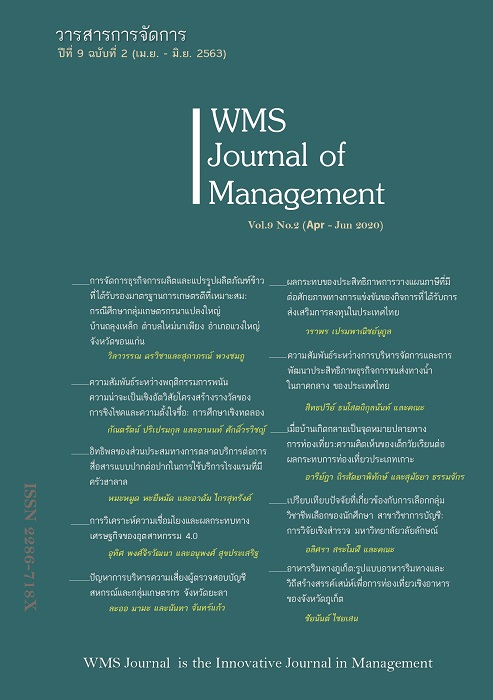An Analysis of Economic Linkage and Economic Impact on Industry 4.0
Main Article Content
Abstract
The objectives of this research were to analyze the linkage of industry 4.0, affecting other main productions, and to analyze the economic impact of industry 4.0 by input-output tables, multipliers, and network analysis. The study divides the production field into 180 productions in 2000, 2005, and 2010. Based on the research, it was discovered that regarding the analysis by using the factors of production and product distribution, industry 4.0 groups mostly utilizes the production factors from the wholesale trade sector and distributed the products to restaurants and drinking places sector. According to the analysis by multipliers, these five groups were the parts of industry 4.0 where the output multipliers increased from 2000 to 2010; it could be because it caused a change of products and production increase. The multiplier in 2010 is 1.81,which increased by 8.35% from 2000. The food, agriculture, and the biotech group had the highest value of multipliers, 2.04, which demonstrated the highest economic impact when this production group changed. Regarding the network analysis, it was found that in 2005, the five production groups were the parts of industry 4.0 at its center of measurement increase from 2005. It means the use of production factors and product distribution from the five groups which were parts of industry 4.0 to the other economies increased in every economic production, and the most actions among the five groups were from the digital group.
Article Details
References
Bartkowiak, A., & Bartkowiak, P. (2017). Technical and technological progress in the context of sustainable development of agriculture in Poland. Journal of Procedia Engineering, 10(182), 66-75.
Karre, H., Hammer, M., Kleindienst, M., & Ramsauer, C. (2017). Transition towards an Industry 4.0 state of the LeanLab at Graz University of Technology. Journal of Procedia Manufacturing, 7(9), 206-213.
Leitão, P., Colombo, W., & Karnouskos, S. (2016). Industrial automation based on cyber- physical systems technologies: Prototype implementations and challenges.
Industry, M. (2010). Input-Output Tables. Retrieved from. https://www.nesdb.go.th/main.php?filename=io_page
Industry, M. (2016). Thailand 4.0. Retrieved from. http://www.industry.go.th/psd/index.php/2016-05-02-05-17-59/item/10820-4-0-20-2560-2579
Thames, L., & Schaefer, D. (2016). Software-defined cloud manufacturing for Industry 4.0. Journal of Procedia CIRP, 16(52), 12-17. Journal of Computers in Industry, 15(81), 11-25.
Wank, A., Adolph, S., Anokhin, O., Arndt, A., Anderl, R., & Metternich, J. (2016). Using a Learning Factory Approach to Transfer Industrie 4.0 Approaches to Small-and Medium-sized Enterprises. Journal of Procedia CIRP, 6(54), 89-94.


